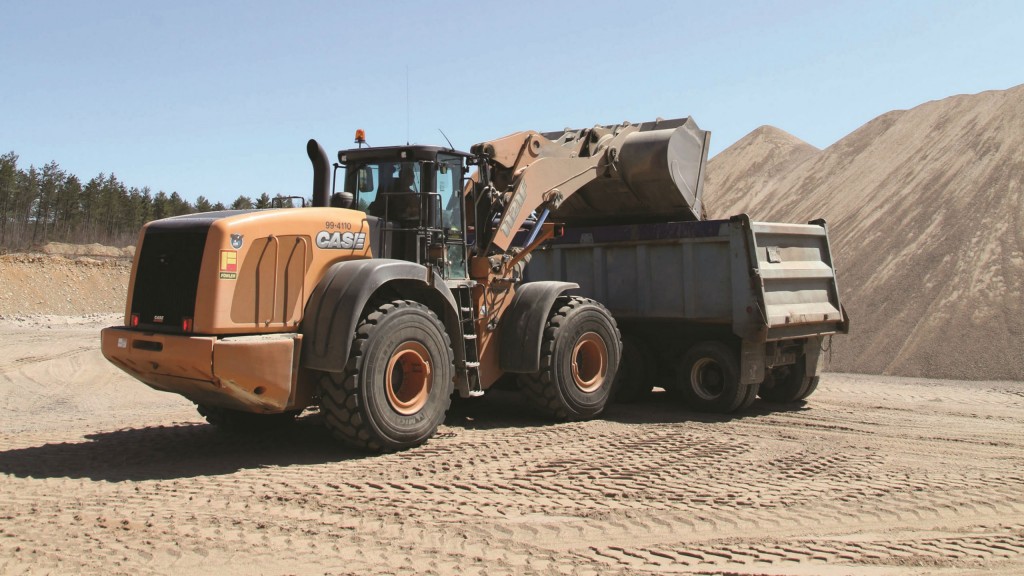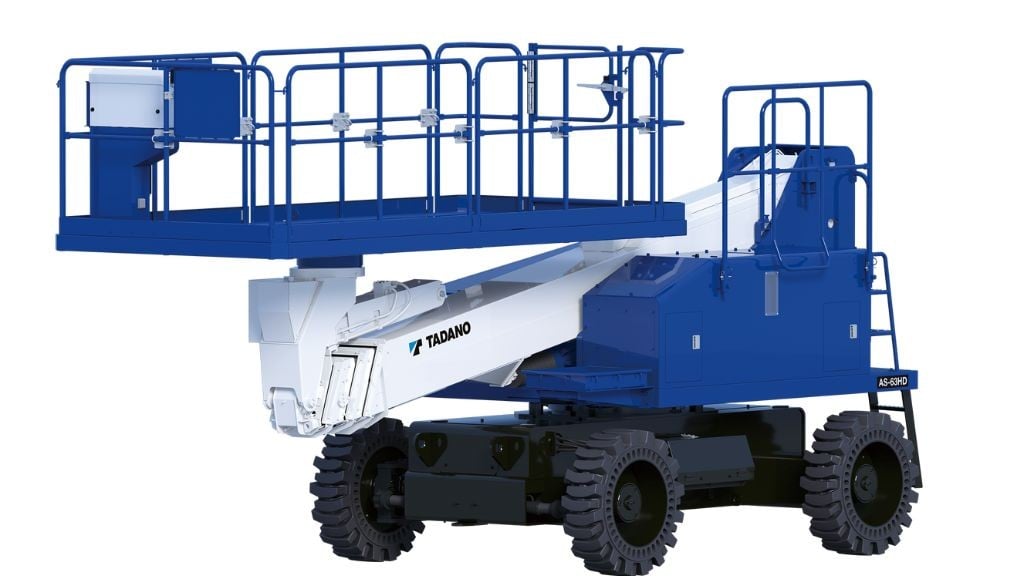Fuel efficiency, performance and right-sizing make Case wheel loader ideal for aggregates producer

The greatest indicator of whether a machine will work in any application is putting that machine under the stress of actual operating conditions before you buy it.
Fowler Construction did just that before deciding to add two new 320-hp Case 1121F wheel loaders to its fleet, working both to load trucks with aggregate and feed the company’s asphalt plants that serve its paving operation. (Fowler Construction is a repeat winner of the Canadian Ministry of Transportation’s provincial “Paver of the Year” award.)
Wheel loaders are arguably the most important piece of production equipment in that application, providing all of the materials to plants that can produce upwards of 2,000 yards of asphalt each day. To perform its tests, Fowler put the 1121F up against comparable loaders from other brands in loading crushers, supplying asphalt plants and loading trucks with aggregate.
The results
“We recorded fuel, operational comforts for the operator, the strength of the machine and we were very well pleased,” says Mark Genders, equipment manager, Fowler Construction. “We came out at 15 litres (3.96 gallons) an hour. It out-performed the current loaders on site. The operators felt very comfortable. The operator fatigue was probably cut in half because of the versatility of the machine [and] how smooth it was. We were very happy with it. That demonstration led to going forward and purchasing 1121s.”
Fowler Construction was founded in Bracebridge, Ontario in 1949 by Archie Fowler, Glen Coates and Ralph Boothby. With humble beginnings in the logging industry, the company expanded over the years and now offers services in road construction, aggregates and asphalt production, as well as water and sewer work, golf course and sports court construction, seasonal road maintenance and excavation, and site preparation.
With more than 400 employees, Fowler is one of the largest employers in the Muskoka, Ontario area, and the company continues to accelerate the growth of the business and its commitment to ongoing improvement.
Part of that improvement is adding new equipment as needed. The company went with the 320-hp wheel loaders with six-yard buckets because that size was optimal both for its summer pit/plant operation, and for winter snow removal and other seasonal work.
One of the most important elements of the selection process was understanding the savings in fuel consumption that a new model would provide. The fuel savings that Genders has experienced with his 1121F wheel loader are the result of several components of the machine working together: the Selective Catalytic Reduction (SCR) engine, four operating modes that allow the operator to tailor the machine output to the application (often at lower rpm), and an industry-exclusive cooling design that requires less machine effort/fuel to operate.
“We were consuming about half the fuel [compared to the company’s older, Tier 3 wheel loaders in the same size class],” says Genders. “When you look at a fleet of 20 to 25 loaders, that’s the biggest [operational factor].”
Using Genders’ data, that the 1121F burned 15 litres/hour, and the price of diesel fuel (using the price from Bracebridge, Ontario on May 31, 2016), the hourly fuel cost of the 1121F is CAD $13.11. The older Tier 3 wheel loaders with double the fuel consumption could require as much as CAD $26.22/hour.
Over the course of a 10-hour shift, the 1121F could provide as much as CAD $131.10 in savings. Those savings are even greater when the company works a 12-hour shift and become even more significant projected out to a fleet of 25 wheel loaders.
Another great advantage of the fuel efficiency is extended runtime. With multiple aggregate sites spread across a 150-km region, those extended runtimes result in fewer required visits from the fuel truck.
“With our geographical region, where our pits and quarries and our jobs are so spread out, I might not be able to have a fuel truck there for 10 to 12 hours, so the site has to run independently until our fuel supply is delivered. That means a huge amount [to us].”
Genders also attributes some of the machine’s fuel savings to the design of its boom (Z-bar) and hydraulics, and how it attacks a pile and comes out compared to other machines.
“I think it’s the drive train, the way it’s designed [and] the Fiat engine,” says Genders. “A big factor that plays into it is the design of the front loader frame. It’s whether or not the machine has the capability of loading the bucket and coming up through the pile, rather than the machine actually fighting itself. The Case is well-balanced. [It] can run at a lower rim pull but more of its horsepower goes to the front loader frame and loads a bucket full, and then leaves the pile again in a timely fashion, which keeps our cycle times all in tune. At the same time, the loader’s not really working that hard to fill the [bucket].”
Downstream efficiency, cycle times and right-sizing
Genders has also spent significant time designing work cycles/envelopes that require the least amount of machine movement to get the job done, and right-sizing each machine to its application. The 1121F with a six-yard bucket is an ideal match both for the truck fleets the company runs (typically filling them in three passes), and the aggregate plant hoppers that the loader is charged with feeding.
“If you’re feeding a plant with something too small,” says Genders, “you’re making, on average, probably a third to a quarter more trips to the plant a day to keep the plant fed. It factors into your fuel, the wear and the tear on the tires, the loader. That’s a big part of it right at the beginning and that’s where you save the money. You’re saving fuel. You’re saving tire wear. Another factor is the stone. The more you handle stone, especially for asphalt, the more it separates. The less you can handle it, the better. The 1121F performs very well in that area.”
Weighing in at more than 60,000 pounds, with a wheelbase just under 12 feet, the 1121F is also extremely stable and agile in both of its core applications.
“[Compared to competitive machines] the cycle times on the 1121F are tighter,” says Genders. “It really performs well excavating sand out of a bank. I don’t have any problems filling the bucket. The loader walks in, comes out with a full bucket, and its traction is very good. It’s not spinning in the sand… which improves its cycle time greatly. You’re going in, you’re getting a bucket, and you’re going right to the plant. Every minute counts, and adds up through the day.”
Genders’ operators report that the wheel loader provides a smooth ride – both 1121Fs are outfitted with Ride Control. Not only does this make the ride easier on the operator and help retain more material in the bucket, but it also plays an important role in the company’s weighing methods.
“The smoothness and the agility of the machine allows the operators to load, weigh on the go, and load the truck,” says Genders. “We put weigh scales on them. If you get a loader that bounces, you can’t weigh because the scales weigh from the fluid in the lift cylinders, so the smoother the loader the more efficient weighing you have, and the more product you ship.”
Cab comfort and visibility
The Case 1121F wheel loader features a spacious cab, ergonomically designed controls and a heated airride seat for operator comfort. The 1121F also features the lowest and narrowest rear hood in the industry for a loader of its size, as well as a wide-angle rear-view camera for improved visibility in tight areas.
“The cabs are very comfortable,” says Genders. “The seats are comfortable. The controls are in good positions, and you can see very well out of the loader. These loaders are very well put together. The operator can sit in the seat and by turning his head, can see all the way around him. The operator can also see out the back of the loader over the hood, where a lot of other machines’ hoods are so big now due to [new emissions designs] that you can’t see over them, and that’s a big benefit.”
Ease of service
With a fully electronic raised hood, environmentally safe fluid drains, sight gauges and easily accessible ground-level checkpoints, the 1121F is designed for simple maintenance. The exclusive Case cooling cube also helps keep the engine cool while minimizing the buildup of debris during operation.
“All the fluid level checks are done within minutes,” says Genders. “The back doors are opened up. The 1121s have the reversing fans where all the coolers are in a box configuration (the cooling cube). The operator can visibly look inside, make sure none of the cooling coils are plugged, which they’re not because of the reversing fan. It takes the operator a matter of minutes, and he’s very comfortable. He doesn’t have to bend over or crawl to look at most spots. Also, these machines have automatic grease systems, so the operator isn’t crawling around and trying to get into tight spots or dangerous areas.”
The 1121F wheel loader comes standard with Case ProCare which the manufacturer claims is the most complete maintenance and support program in the industry, providing a 3-year/3,000-hour full-machine factory warranty, a 3-year/3,000-hour planned maintenance contract, as well as a 3-year advanced SiteWatch telematics subscription.
“I have to say that Case is a leader in the industry with what they’ve done with ProCare,” says Genders. “It’s a very well put together program. It works very well for us. We have our own lubrication truck but I rely on our Case dealer (Strongco Equipment) to actually service this machine and if there are any small issues that arise, they address them on those visits. I’m very pleased with the way that’s going.”



